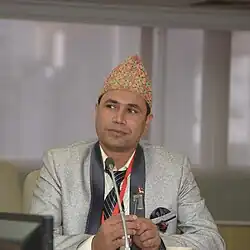Khimlal Gautam
Khim Lal Gautam | |
|---|---|
 Khim Lal Gautam in a conference. | |
| Nationality | Nepali |
| Occupation(s) | Surveyor, civil servant |
| Notable work | Pandhrau Chuli (Non-fiction book, 2022) |
Khim Lal Gautam (Nepali: खिमलाल गौतम): is a Nepalese mountaineer and Chief Survey Officer in the Survey Department, Government of Nepal.[1] He is the world's only civil servant and surveyor to have scaled the Mount Everest twice.[2] Additionally, he holds the distinction of being the highest-ranking government official from the Nepal government to have summited Everest. Gautam, along with Rabin Karki, was the first surveyor to reach the top of the mountain to measure its actual altitude using state-of-the-art technology.[3] Khimlal also serves as a representative and liaison officer for the Department of Tourism in Nepal.[4][5]
Early life and education
Gautam was born in the Hadaule, a small village in Nepal Kaski District where he spent his entire childhood.[6] Growing up, he was enchanted by the sight of Mt Machapuchhre, just 20 kilometers away from his home, which fueled his love for Nepal's majestic mountains.[7] Despite this, it was Mount Everest that truly captured his imagination, being famous as the tallest peak in the world.[6]
Growing up in Handaule, surrounded by the majestic Himalayas, Gautam developed a deep love for the mountains and a lifelong dream of exploring them. His early experiences in this natural wonderland instilled in him a profound respect for nature and a strong connection to the Himalayas, which he often credits as the inspiration behind his remarkable mountaineering achievements.[6]
Gautam has obtained his master's degree in Geographical Information Science and Systems from the Universität Salzburg.[8]
First summit

In 2010, Gorkhapatra daily published an advertisement inviting interested civil servants of Nepal to apply for the inaugural civil servant expedition to summit Mount Everest, as part of the Visit Nepal Year 2011 promotion program[9]. Despite applying, he was not initially selected and ended up being an alternate candidate. However, an opportunity arose when a team member had to attend a foreign function, and he was accommodated in the team. On May 18, 2011, they successfully reached the summit at exactly 5:20 am. He was the first among his team to reach the summit.[10][11]
Second summit
In 2017, following the 2015 Nepal Earthquake, Nepal's Survey Department organized an expedition to Mount Everest to reassess its height.[12][13] Khim Lal Gautam, chosen as the team leader for his mountaineering experience and engineering skills, led the expedition[10][14]. The then Prime Minister of Nepal, KP Oli, bid farewell to the team on April 10, 2019.[15] After extensive preparation and acclimatization at Base Camp over 26 days, the team began their ascent on May 18.[1] However, adverse weather conditions and a shortage of oxygen bottles at the South Col posed challenges.[16] Despite these obstacles, Gautam pressed on, aware that descending would likely result in failure based on his prior Everest experience. On May 22, at 3 a.m., Gautam, along with colleague Rabin Karki and Sherpa, successfully reached the summit of Mount Everest, achieving their mission despite the difficulties faced.[17][18][19]
Book
Pandhrau Chuli is a book that chronicles the author Khim Lal Gautam's experiences and explorations related to Mount Everest.[22][23] It delves into the emotional and geographical aspects of Everest, weaving together personal anecdotes, historical facts, and insights gained from Gautam's two ascents of the mountain.[23] The narrative captures the essence of courage, risk, and struggle encountered during Everest expeditions, while also shedding light on the broader history of Everest exploration. Through Gautam's unique perspective as both a nationalist and a private individual, the book offers readers a deep and multifaceted understanding of Everest and its significance.[22][23]
Role of Gautam in Monitoring Mount Everest's Glacier Changes
Gautam has also contributed significantly to monitoring environmental changes on Mount Everest, particularly around the Khumbu Glacier and Everest Base Camp.
Observations on Glacier Melt
In the spring of 2021, Gautam visited Everest Base Camp and was struck by the unusually loud sound of meltwater flowing beneath the glacier’s surface, which he attributed to accelerating glacial melt caused by rising temperatures in the Himalayas.[24][25]
Assessment of Human Impact
Gautam documented several human activities that were intensifying the melt:
- Removal of surface debris to set up tents, which allowed more heat and sunlight to penetrate the glacier.[24][25]
- Use of propane gas across the camp, which he estimated melted over three million kilograms of ice per climbing season.[24][25]
- Daily discharge of approximately 4,000 liters of urine onto the glacier, contributing additional thermal load.[24][25]
Policy Recommendations
Gautam co-authored a 2022 report for the Government of Nepal recommending the relocation of Everest Base Camp near Gorak Shep. He warned that, without intervention, the Khumbu Glacier could soon be left without any ice due to the combined effects of climate change and human pressure.[24][25]
Gautam’s View: Where Mountains Meet Mythology
According to Hindu mythology, Mount Everest was known as Naubandhana, meaning “boat anchor.” The name originates from the account in the Matsya Purana and the Mahabharata, which describes a great flood at the end of the sixth Manu era (Chakshusha). During this event, Lord Vishnu, in His Matsya (fish) avatar, guided King Satyavrat (later Vaivasvata Manu) to tie a boat carrying sages and seeds of life to the peak of the tallest mountain to survive the flood. This peak, which remained above the water, was later identified as Everest, or Naubandhana.[26]
The Mahabharata refers to what was considered the highest peak in the world at the time, as lying beyond the Himalayas and still known as Naubandhana, marking it as the resting place of the flood boat. A yellow band (limestone layer) near Everest’s summit is interpreted as the line where the boat was tied, according to this legend.[26]
Deduction on the Origin and Dating of Mount Everest
Gautam, drawing from Vedic cosmology and traditional Hindu timekeeping, calculated that the tying of the boat to Mount Everest occurred approximately 122 million years ago, marking the transition from the sixth to the seventh (Vaivasvata) Manu era.[26]
This mythological timeline contrasts with the geological estimate that the Himalayas began forming around 40–50 million years ago. However, Gautam notes that this discrepancy is not as wide when compared to the Biblical timeline for the Great Flood, which places it only 4,372 years ago.[26]
See also
References
- ^ a b Gautam, Khim Lal (17 October 2020). "Measuring Mt Everest: because it is there". Nepali Times. Retrieved 17 June 2021.
- ^ "Nepali surveyor's arduous journey to get to 8,848.86". Record Nepal. Bhadra Sharma. Retrieved 17 June 2021.
- ^ "Expedition to remeasure height of Everest". Mountain Planet. Daily Mountain. Retrieved 19 June 2021.
- ^ https://risingnepaldaily.com/news/43393
- ^ https://myrepublica.nagariknetwork.com/news/kami-rita-sherpa-summits-mt-everest-for-30th-time-breaks-own-previous-record/
- ^ a b c "Everest Day: A conversation with Nepal's Everest height measurement leader". Online Khabar. 30 May 2020. Retrieved 30 March 2024.
- ^ "सगरमाथा दिवस: यी नेपाली जसले धेरैथोक गुमाएर पनि हासिल गरे सर्वोच्च शिखरको नयाँ उचाइ". BBC. 29 May 2022.
- ^ "Rising Stars Biography". Geospatial Media. Geospatial Media and Communications.
- ^ "Nepal civil servants set to conquer Mt Everest". New Indian Express. 16 May 2012.
- ^ a b Gautam, Khimlal. "Everest Day: A conversation with Nepal's Everest height measurement leader". Online Khabar (Interview). Interviewed by Birat Anupam.
- ^ Gautam, Khim Lal (10 December 2020). "Two hours on the summit". Geospatial World.
- ^ "Measuring Mount Everest: a proud Nepali on his dangerous mission to the top of the world". South China Morning Post. 10 November 2020.
- ^ "Expedition to remeasure height of Everest". Agence France Presse. 9 April 2019 – via The Himalayan Times.
- ^ Gautam, Khim Lal (2011). "Feelings of the first Nepali Surveyor on top of Mount Everest". Nepalese Journal of Geoinformatics. 10 (2011): 48. doi:10.3126/njg.v10i0.23192. S2CID 239297013.
- ^ "PM Oli bids farewell to government team assigned to measure Everest's height". Ratopati. Retrieved 28 June 2021.
- ^ Slater, Joanna (17 October 2019). "Is Mount Everest shrinking? Nepal is on a mission to find out". Washington Post.
- ^ "The Quest for the Highest Point". The American Surveyor. Jodie Hartnell. 8 February 2021.
- ^ "How do you measure Everest? It's complicated by frostbite—and politics". National Geographic. Freddie Wilkinson. 28 September 2020. Archived from the original on February 17, 2021.
- ^ "Mt Everest grows by nearly a metre to new height". BBC News. 8 December 2020.
- ^ Gautam, Khimlal (2022). Pandhraun Chuli (1st ed.). Fine Print. p. 351. ISBN 978-9937-746-48-9.
- ^ "A firsthand account of a Nepali surveyor's Everest summits". kathmandupost.com. Retrieved 2023-09-08.
- ^ a b "Book Launched 'Pandhrau Chuli' Written by Author and Surveyor Khim Lal Gautam". Collegenp. College Nepal.
- ^ a b c "A firsthand account of a Nepali surveyor's Everest summits". Kathmandu Post.
- ^ a b c d e "Mount Everest Is on Thin Ice", The Wall Street Journal, December 14, 2023.
- ^ a b c d e "Nepal to move Everest base camp from melting glacier". BBC News. 17 June 2022.
- ^ a b c d Gautam, Khim Lal. "Beloved Mystic Mountains." Hinduism Today, July/August/September 2023.